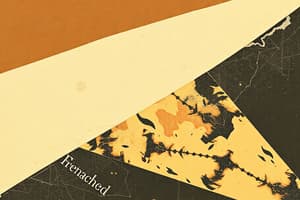Podcast
Questions and Answers
What is the method to determine the area of a parallelogram?
What is the method to determine the area of a parallelogram?
- Add the lengths of all sides and multiply by two.
- Draw the diagonals and calculate the triangles formed.
- Multiply the base by the height. (correct)
- Find the area of the rectangle formed by cutting and rearranging the parallelogram. (correct)
What must be drawn from a vertex to determine the height of the parallelogram?
What must be drawn from a vertex to determine the height of the parallelogram?
- A curved line connecting adjacent vertices.
- A diagonal line to the opposite vertex.
- A line parallel to one of the sides.
- A perpendicular line to the opposite side. (correct)
After moving the triangle cut from the parallelogram, what shape is formed?
After moving the triangle cut from the parallelogram, what shape is formed?
- A trapezoid.
- A square.
- A rectangle. (correct)
- An irregular polygon.
In calculating the area of a rectangle formed from a parallelogram, what are the dimensions used?
In calculating the area of a rectangle formed from a parallelogram, what are the dimensions used?
Which statement accurately describes the relationship between the area of the parallelogram and the rectangle formed?
Which statement accurately describes the relationship between the area of the parallelogram and the rectangle formed?
What does the area of a parallelogram equal when transformed into a rectangle?
What does the area of a parallelogram equal when transformed into a rectangle?
Which term correctly describes the vertical line drawn from a vertex of the parallelogram?
Which term correctly describes the vertical line drawn from a vertex of the parallelogram?
In determining the dimensions of the rectangle formed, which measurement is considered the length?
In determining the dimensions of the rectangle formed, which measurement is considered the length?
What shape is created after the triangle cut from the parallelogram is repositioned?
What shape is created after the triangle cut from the parallelogram is repositioned?
Which statement accurately represents the relationship between the height and the area of the parallelogram?
Which statement accurately represents the relationship between the height and the area of the parallelogram?
What represents the base in the area calculation of a parallelogram?
What represents the base in the area calculation of a parallelogram?
Which key geometric transformation involves the triangle cut from the parallelogram?
Which key geometric transformation involves the triangle cut from the parallelogram?
What is the relationship between the height of the parallelogram and the rectangle formed after the transformation?
What is the relationship between the height of the parallelogram and the rectangle formed after the transformation?
Why can a parallelogram be transformed into a rectangle during area calculations?
Why can a parallelogram be transformed into a rectangle during area calculations?
In determining the area of a parallelogram, why is it emphasized to draw a perpendicular line from a vertex?
In determining the area of a parallelogram, why is it emphasized to draw a perpendicular line from a vertex?
Flashcards
Area
Area
The amount of space a two-dimensional shape covers.
Parallelogram
Parallelogram
A flat shape with four sides where opposite sides are parallel and equal in length.
Height of a parallelogram
Height of a parallelogram
A line segment drawn perpendicularly from one side of a parallelogram to the opposite side.
Base of a parallelogram
Base of a parallelogram
Signup and view all the flashcards
Area of a parallelogram
Area of a parallelogram
Signup and view all the flashcards
Parallelogram-Rectangle Transformation
Parallelogram-Rectangle Transformation
Signup and view all the flashcards
Perpendicular line in a Parallelogram
Perpendicular line in a Parallelogram
Signup and view all the flashcards




